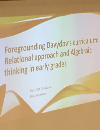
Polotskaia, E., & Sabena, C. (2018). Colloquium: Foregrounding Davydov’s curriculum: Relational approach and algebraic thinking in early grades. In PME42. Umea, Sweden.
Abstract: Based on a dialectical materialist theoretical understanding of humans and the world, Vasily Davydov (2008) articulated an educational program known as the Elkonin-Davydov curriculum that features a theory of developmental instruction. Two of the chief ideas of this theory are (1) a relational approach to number concept —which entails shifting teaching and learning from arithmetic operations to quantitative relationships—and (2) a materialist view about theoretical thought —which emerges in practical, culturally shaped activities with artefacts, language, and gestures. In this colloquium, two research reports and a theoretical essay explore opportunities in developing algebraic thinking that arise from Davydov’s work. The authors frame knowledge development as an increasingly sophisticated, artefact-mediated, dialectical articulation of actions, gestures, signs, and words (Radford, 2011). Mellone et al. (research 1) implemented the Davydov curriculum in Grade one, and analysed the attention paid by the students to the structure of the situation (pouring liquid from two containers is put into one) and to the relationships between quantities. The students expressed the additive relationship using graphical representations, surfaces of rectangles, and simple algebraic expressions. Ericsson (research 2) used a context of mixed fractions to facilitate students’ development of algebraic thinking. This paper suggests that the mixed fraction encodes two relationships: an additive relationship between the integer part and the fractional part and a multiplicative relationship between the numerator and the denominator of the fractional part. Polotskaia et al. (theoretical essay) critically review the epistemology and existing classifications of multiplicative situations. Based on Davydov’s relational perspective, this paper proposes a new classification of multiplicative structures and a set of graphical representations to implement in teaching and learning contexts aiming relational and algebraic reasoning development. All three reports emphasise the relational approach to teaching mathematics and the special role that graphical and other semiotic devices play in the emergence of culturally shaped theoretical knowledge.



